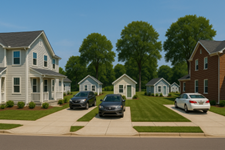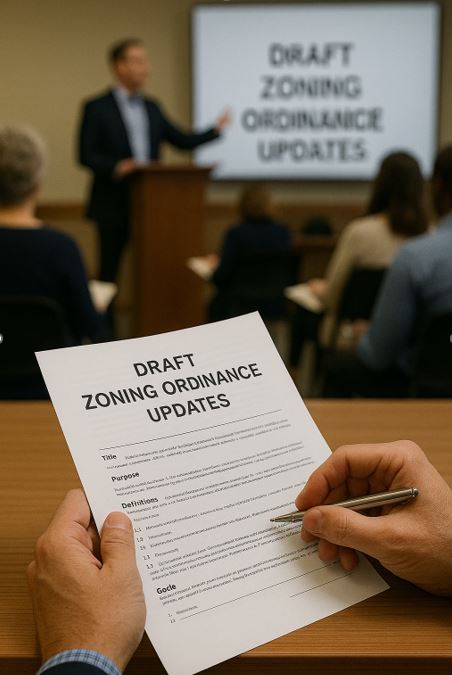The Iowa Legislature recently passed a few key zoning-related laws effective July 1, 2025, notably including a mandate for Accessory Dwelling Unit (ADU) allowances and refining the criteria by which Boards of Adjustment consider variance requests.

Alongside these newly enacted laws, renewed attention around renewable energy siting, local aesthetic controls, and other planning issues are prompting Iowa municipalities to confront critical questions about how to modernize their zoning regulations while preserving local identity.
This article explores the practical implications of some of Iowa’s zoning-related legislative updates, outlining what communities need to know and how local governments should update their zoning ordinances to reflect both state requirements and hometown values.
From Planning Trends to Policy
The bills passed during the 2025 Iowa legislative session directly impact how municipalities regulate and administer planning and zoning. However, communities should also pay attention to the bills that were proposed but not enacted this legislative session as they reflect broader planning priorities and underscore the need for municipal zoning ordinances to evolve in response. Below are some of the most prominent planning trends and the related legislation that’s shaping local decision-making.
Accessory Dwelling Units (ADUs): Expanding Housing Options
Once seen as a niche strategy, Accessory Dwelling Units (ADUs) are now a widely adopted tool for addressing local housing needs. Communities are embracing them as a solution to diversify the housing stock, increase affordability, and support multigenerational living.

Senate File 592 (Enacted)
This bill requires municipalities to allow at least one ADU by right on any lot that also has a single-family residence. It overrides local control over ADU design, permitting, and occupancy — compelling communities to revise their zoning ordinances and consider whether existing infrastructure can accommodate additional units. Although the law allows for reasonable local standards, communities were required to update their zoning ordinances by July 1, 2025, to ensure compliance — and to clearly define how they intend to regulate ADUs within the scope of what the law permits and aligns with their local goals.
Renewable Energy: Preparing for A Sustainable, Clean Future
Iowa communities are facing growing interest in both large- and small-scale renewable energy projects, prompting communities to reassess their zoning ordinances to effectively address wind, solar, and battery energy storage systems.

House Study Bill 317 (Proposed, Not Enacted)
This bill sought to establish a statewide standard for the siting and operation of renewable electric power-generating facilities, effectively removing local discretion by setting maximum setback distances and other siting parameters. While it did not pass, it highlights a growing policy discussion that is likely to return in a future session. Communities that have not yet addressed renewable energy in their zoning ordinances may benefit from doing so — to provide clear local guidance, support thoughtful development, and stay aligned with evolving policy discussions.
Landscaping and Design Standards: Balancing Flexibility and Identity
Landscaping and design standards have long been used to help communities better define character, support placemaking, and guide development quality. However, recent legislative proposals suggest a shift toward limiting how local governments regulate these elements — particularly in commercial and multifamily contexts — as these tools have come under scrutiny for potentially restricting housing variety or increasing development costs.

Senate File 498 (Proposed, Not Enacted)
This bill sought to prohibit municipalities from regulating specific landscaping materials, products, or aesthetic styles in commercial and multi-family zoning districts. While it did not pass, it reflects growing interest in limiting local aesthetic controls. In anticipation of a similar proposal in a future session, communities may want to review their zoning ordinances, including site plan requirements, to clarify or reconsider aesthetic-based landscaping and design standards.
Variance Processes: Clarifying Standards and BOA Authority
Boards of Adjustment (BOAs) serve as a key decision-making body in municipal zoning administration — reviewing variances, conditional use permits, and appeals. While they provide essential flexibility within the zoning framework, unclear or inconsistent standards — particularly for variances — can lead to confusion, disputes, or uneven application.
House File 652 (Enacted)
This bill updates the variance standard from “unnecessary hardship” to a more flexible “practical difficulties” test, clarifying BOA authority and strengthening legal defensibility — especially for irregular sites and situations. Communities should consider updating the variance language in their zoning ordinance, variance application materials, and BOA training to reflect the new criteria. With the revised criteria, variance requests may increase, making clear procedures and thorough documentation essential.
This trend-to-policy evolution reinforces a key message: zoning ordinances are living documents. As community planning objectives evolve and state policy adapts to support or challenge them, municipalities must regularly revisit and update their ordinances.

What’s at Stake?
For many communities — particularly those without an adopted zoning ordinance or with one that hasn’t been comprehensively updated in years — these recent legislative changes present both a challenge and an opportunity. Without timely updates, local zoning ordinances risk:
- Noncompliance with state law
- Legal ambiguity in interpreting or applying outdated standards
- Inefficiency in managing land use requests and applications
- Missed opportunities to proactively shape growth and development
More importantly, zoning is not just about regulation — it is about reflection. Zoning ordinances reflect a community’s goals, character, and priorities. Updating ordinances in response to state changes does not mean losing local identity — it means aligning regulations with both legal clarity and community values.
Conclusion
Zoning influences everything from land use and housing choices to the form, feel, and future of neighborhoods. As state-level policy continues to evolve, the authority that local governments hold over zoning is also shifting — prompting cities and counties to revisit their zoning ordinances to ensure continued effectiveness and compliance.
Updating a community’s zoning ordinance is more than a legal necessity — it is an opportunity. An opportunity to make the zoning ordinance clearer, consistent, enforceable, and better aligned with how a community wants to look, feel, function, and grow.
